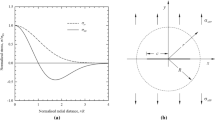Abstract
The results of experimental creep crack growth tests, using compact tension specimens, made from a Ni-base superalloy (Waspaloy) at 700^C are presented. The experimental results indicate that the creep crack growth rate data for the Ni-base superalloy Waspaloy, at 700^C, can be correlated using the C* parameter, calculated from load-line displacement rates. The mode-I stress intensity factor, KI, does not appear to be capable of correlating the data except at high creep crack propagation rates. Analytical solutions indicate that creep crack growth was occurring under transient creep conditions in the experiments. Finite element (FE) simulations were performed in which the experimentally determined crack growth versus time results were imposed. The good agreement between the resulting FE solutions for load-line displacements and corresponding C* values with the experimental results show that the FE simulation was successful. The FE simulation revealed that the creep zone increases as the crack growth and a transient state of creep occurs in the vicinity of the advancing crack tip. An apparent correlation between the crack growth rates and the C* parameter has been shown. This information is helpful in assessing the likely usefulness of the C* and KI parameters for predicting creep crack growth in more general situations.
Similar content being viewed by others
References
ABAQUS (1995). version 5.4 users manual, HKS.
Ainsworth, R.A. and Budden, P.J. (1993). Assessment of defects at high temperature: the R5 procedure. Behaviour of defects at high temperature, ESIS-15, (Edited by R.A. Ainsworth and R.P. Skelton), MEP, 453-466.
ASTM Standard E1457-92 (1992). Standard test method for measurement of creep crack growth rates in metals.
Bassani, J.L. and Hawk, D.E. (1990). Influence of damage on crack-tip fields under small scale creep conditions. International Journal of Fracture 42, 157-172.
British Standard BS 5447, (1977). Methods of test for plane strain fracture toughness (K IC) of metallic materials. British Standards Institution.
Chambers, A.C., Hyde, T.H. and Webster, J.J. (1991). Mixed mode fatigue crack growth at 550°C under plane stress conditions in Jethete M152. Engineering Fracture Mechanics 39, 603-619.
Graham, A. and Walles, K. (1955). Relationships between long and short term creep and tensile properties of a commercial alloy. Journal Iron Steel Inst. 179.
Hall, D.E., Hamilton, B.C., McDowell, D.I. and Saxena, A. (1997). Creep crack growth behaviour of aluminium alloy 2519-part II Numerical analysis, ASTM STP 1297, 19-36.
Harper, M.P. and Ellison, E.G. (1977). The use of the C* parameter in predicting creep crack propagating rates. Journal Strain Analysis 12, 167-179.
Hayhurst, D.R., Brown, P.R. and Morrison, C.J. (1984). The role of continuum damage in creep crack growth. Philosophical Trans. Royal Society London A311, 131-158.
Hyde, T.H., Low, K.C. and Webster, J.J. (1983). Elastic-plastic-creep behaviour of a compact tension specimen. Journal Strain Analysis 18, 157-166.
Kumar, V. and Shih, C.E. (1980). Fully plastic crack solution with applications to creep crack growth. International Conference on Engineering Aspects of Creep — Vil. 1, I Mech E, 211-214.
Nikbin, K.M., Smith, D.J. and Webster, G.A. (1986). An engineering approach to the prediction of creep crack growth. Journal of Engineering Materials and Technology, Transaction of the ASME 108, 186-191.
Riedel, H. (1987). Fracture at High Temperatures, Springer-Verlag, Berlin.
Riedel, H. and Rice, J.R. (1980). Tensile cracks in creeping solids. ASTM-STP 700, 112-130.
Webster, G.A. (1992). Lifetime estimates of cracked higher temperature components. International Journal of Pressure Vessels and Piping 50, 133-145.
Wilkinson, D.S. and Biner, S.B. (1988). Creep crack growth simulation under transient stress fields. Metallurgical Transactions 19A, 829-835.
Rights and permissions
About this article
Cite this article
Xia, L., Becker, A. & Hyde, T. An Assessment of the C* and KI Parameters for Predicting Creep Crack Growth in a Ni-Base Superalloy (Waspaloy) at 700^C. International Journal of Fracture 92, 39–54 (1998). https://doi.org/10.1023/A:1007415306833
Issue Date:
DOI: https://doi.org/10.1023/A:1007415306833




